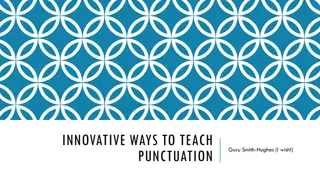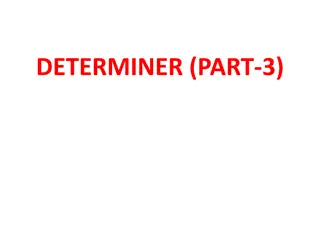English Language Basics - SPaG/GaPS, Determiners, Adjectives, Nouns, Pronouns, Relative Pronouns, Punctuation
Enhance your understanding of English language basics with concepts such as SPaG/GaPS, determiners, adjectives, nouns, pronouns, relative pronouns, and punctuation. Dive into the world of grammar essentials for Key Stage One and Two learners, covering topics like parts of speech, sentence structure, and punctuation rules.
Download Presentation

Please find below an Image/Link to download the presentation.
The content on the website is provided AS IS for your information and personal use only. It may not be sold, licensed, or shared on other websites without obtaining consent from the author. Download presentation by click this link. If you encounter any issues during the download, it is possible that the publisher has removed the file from their server.
E N D
Presentation Transcript
SPaG/GaPS Spelling, Punctuation and Grammar
Determiner A determiner specifies whether a noun is known or unknown. a (an), the, those, this, my, your
Adjective An adjective describes a noun. house
Noun A noun is a person, place or thing. Key Stage One
Pronoun Possessive Pronoun Pronoun A pronoun replaces nouns to avoid repetition. her him those she his these my this that mine
Relative Pronoun A relative pronoun is used to begin a description for a noun. who, which, that, where, when It s used to introduce a relative clause.
Punctuation for Parenthesis Parenthesis is additional information inserted into a sentence as further explanation or an afterthought. . , ? ! : ; () -
Noun Phrases A noun phrase is a group of words, in which the noun is the most important.
fox the fox the gentle fox the gentle, caring fox the gentle, caring fox with a heart of gold
Key Stage One using some expanded noun phrases to describe and specify
Key Stage Two using some expanded noun phrases effectively to add detail, qualification and precision
Verb A verb is a doing word . They can be classified by their tense: past, present or future.
Adverb An adverb describes a verb. It usually tells us how, when or where.
Modal Verb A modal verb expresses certainty. Key Stage Two
Prepositions/Preposition Phrases A preposition often describes a location or direction.
Key Stage Two using preposition phrases to add detail, qualification precision and
Conjunctions (Connectives) A conjunction links two words or phrases together. co-ordinating subordinating
co-ordinating F A N B O Y S o subordinating or nd or ut r et A lthough, as, after W I T E Hile, when, which f, in order that hough, that ven though, even if B U S ecause, before ntil, unless ince
Key Stage One using co-ordination (or/and/but) and some (when/if/that/because) subordination
Key Stage Two using subordinating conjunctions co-ordinating and
Subordinate Clause A subordinate clause is a clause which is subordinate to another part of the sentence. It is introduced using a subordinating conjunction. subordinate: lowly, minor, inferior, lesser
Key Stage Two Relative clauses are always subordinate.
Statement Key Stage Two Question Exclamation Command
Key Stage One using sentence with different forms in their (statements, exclamations and commands) writing questions,
Colon (:) vs. Semi-Colon (;) A colon (:) is used to provide a pause, before introducing related information. It is often used to introduce a list. To make the perfect jam sandwich, you will need three things: bread, jam and butter.
Colon (:) vs. Semi-Colon (;) A colon (:) is used to provide a pause, before introducing related information. It can also be used to introduce a definition or explanation of something. I know how I m going to handle this: I m going to hide!























